Berching
BERCHING
State : Bayern
District (Kreis) : Eichstätt (until 1973 Beilngries)
Additions : 1972 Ernersdorf, Fribertshofen, Oening, Pollanten, Raitenbuch, Rudertshofen, Sollngriesbach, Staufersbuch, Stierbaum, Thann, Wallnsdorf, Wattenberg, Weidenwang, Winterzhofen; 1976 Erasbach, Holnstein (1971 Altmannsberg), Plankstetten
| German |
Geteilt von Blau und Silber; unten ein wachsender, rot gekleideter Bischof mit Mitra, links ein zugewendeter goldener Bischofsstab. |
| English | blazon wanted |
Origin/meaning
The oldest known seal dates from 1320 and shows two crossed crosiers, symbol for the Eichstätt Abbey, to which the town belonged at the time. The same composition appears as arms in 1496 as silver crosiers in a red field.
At the meantime the seals of the city used since 1342 a composition with the two crosiers above a bust of a bishop. When the State of Eichstätt was incorporated into Bayern in 1803 the crosiers disappeared and the present arms were adopted in 1819. The colours are the colours of Bayern.
Hupp showed in the 1920s still the old arms, which he considered as the true arms for the city, see below.
| The arms by Hupp in the Kaffee Hag albums +/- 1925 |
This page is part of the German heraldry portal Deutsche Wappensammlung |
Heraldry of the World |
|
German heraldry:
|
Selected collector's items from Germany:
|
Literature: Stadler, 1964-1971, 8 volumes; Hupp, O: Kaffee Hag albums, 1920s



